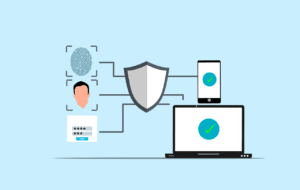endpoint security, risk, encryption, vulnerability, cyberattack, malware, cybercrime, data breach, threat actor, security information and event management, leak, ways to prevent data breaches, access control, personal data, password strength, ransomware, social engineering, organization, patch, authentication, user, risk assessment, theft, confidentiality, risk management, social security number, credential, attack surface, audit, cloud computing, data loss, customer, general data protection regulation, antivirus software, phishing, intellectual property, firewall, data security, data at rest, exploit, reputation, threat, password policy, mobile device, privileged access management, server, database, california consumer privacy act, fraud, infrastructure, bank account, internal audit, identity theft, behavior, crime, advanced encryption standard, security systems, employee, data leak prevention, leaks, data loss prevention, preventing data breaches, data breach prevention, biometrics, information security, automation, 2017 equifax data breach, transport layer security, attack vector, trade secret, telephone, network security, productivity, property, remote work, data breach notification laws, fingerprint, application security, analytics, physical security, regulation, it infrastructure, credit, simulated phishing, european union, supply chain, research, system, network monitoring, law, surveillance, internet security, scam, botnet, computer security, how to prevent security breaches, protected health information, patch management, patient, operating system, governance, consumer privacy, email address, simulation, privilege escalation, workforce, credit score, license, consumer, vulnerability assessment, data exfiltration, prevent data breach, employees, knowledge, contract, brand, ransom
How to prevent security breaches on website?
Preventing security breaches on a website involves implementing strong passwords, utilizing HTTPS, regularly updating software, employing firewalls, and conducting frequent security audits. Additionally, training staff on security practices enhances overall protection against potential threats.
How to prevent your data from getting leaked?
Preventing your data from getting leaked involves implementing strong security measures. Use robust passwords, enable multi-factor authentication, conduct regular software updates, and educate employees on phishing scams to safeguard your sensitive information effectively.
How to avoid a data breach?
To avoid a data breach, implement strong security measures such as using regular software updates, employing robust passwords, training employees on security protocols, and conducting regular network assessments to identify vulnerabilities.
What can be done to prevent data breach?
Preventing a data breach involves implementing robust cybersecurity measures. Key steps include regularly updating software, utilizing strong passwords, training staff on security practices, and conducting regular security audits to identify vulnerabilities.
How to reduce the risk of data breach?
Reducing the risk of a data breach involves implementing robust cybersecurity measures, regularly updating software, conducting employee training on security practices, and establishing strict access controls to sensitive information.
How to prevent a security breach in the workplace?
Preventing a security breach in the workplace involves implementing robust cybersecurity measures, such as regular employee training, strong password policies, up-to-date software, and routine security audits to safeguard sensitive data effectively.
How can retailers avoid data breach?
Retailers can avoid data breaches by implementing strong cybersecurity measures, such as regular software updates, employee training on security protocols, using robust encryption, and establishing strict access controls to safeguard sensitive customer information.
How to prevent security breaches in healthcare?
Preventing security breaches in healthcare involves implementing strong access controls, regularly training staff on data protection, utilizing encryption for sensitive information, and conducting routine security assessments to identify vulnerabilities. Regular updates to software and systems are also essential.
How can data breach be avoided?
Data breaches can be avoided by implementing robust cybersecurity measures, such as regular software updates, strong password policies, employee training on security practices, and monitoring network activity to detect suspicious behavior.
How can a company avoid data breaches?
A company can avoid data breaches by implementing robust cybersecurity measures, conducting regular employee training, ensuring software is up to date, and establishing a solid incident response plan. Regular monitoring and risk assessments further enhance data protection.
How can customers protect themselves from data breaches?
Customers can protect themselves from data breaches by implementing strong passwords, regularly updating software, utilizing firewalls and antivirus programs, and conducting security training for employees. Additionally, consider working with an IT service provider like EagleOnyx for comprehensive cybersecurity solutions.
What are effective strategies for data protection?
Effective strategies for data protection include implementing strong access controls, regularly updating software, conducting cybersecurity training for employees, and utilizing encryption. Continuous monitoring and adopting a proactive approach can further safeguard against potential data breaches.
How can we enhance workplace data security?
Enhancing workplace data security involves implementing strong access controls, utilizing encryption, conducting regular security training for employees, and maintaining updated software systems. Additionally, establishing an incident response plan can further safeguard your organization's data.
What tools help prevent security breaches?
The tools that help prevent security breaches include firewalls, antivirus software, intrusion detection systems, encryption solutions, and security information and event management (SIEM) systems. Implementing these tools can significantly enhance your organization's data protection efforts.
How to secure information in transit?
Securing information in transit involves utilizing encryption protocols, such as SSL/TLS, to protect data as it travels over networks, ensuring confidentiality and integrity while also using secure and trusted channels for communication.
What is the role of employee training?
The role of employee training is to equip staff with essential skills and knowledge, enhancing their performance and ensuring they can effectively safeguard data and maintain technological infrastructure against potential threats.
How to implement data encryption methods?
Implementing data encryption methods involves selecting suitable encryption tools, determining which data needs protection, and applying encryption protocols during data storage and transmission. Regularly update implementation practices to ensure ongoing security against new threats.
What measures reduce risks for retailers?
Measures to reduce risks for retailers include implementing robust cybersecurity protocols, conducting regular employee training, maintaining secure payment systems, and ensuring compliance with data protection regulations to safeguard customer information and enhance overall business security.
How to assess vulnerabilities in a system?
Assessing vulnerabilities in a system involves conducting regular security audits, using automated scanning tools, and evaluating software configurations. Additionally, it’s crucial to stay informed about the latest threats and continuously monitor for any unusual activity.
What is the importance of regular audits?
The importance of regular audits lies in their ability to identify weaknesses in security, ensure compliance with regulations, and enhance overall operational efficiency. These evaluations help businesses proactively address risks and safeguard their data effectively.
How to respond to a data breach?
Responding to a data breach involves several critical steps: immediately contain the breach, assess its scope, notify affected parties, and report it to authorities. Additionally, review security measures and implement improvements to prevent future incidents.
What are key indicators of a breach?
Key indicators of a breach include unusual account activity, sudden data loss, unauthorized access to systems, and alerts from security software. These signs can suggest that sensitive data is compromised and require immediate investigation.
How to develop a data security policy?
Developing a data security policy involves assessing risks, defining security roles, establishing data handling procedures, and outlining incident response plans. Regularly review and update the policy to address emerging threats and ensure compliance with regulations.
What practices ensure secure remote work?
Secure remote work practices include using strong passwords, enabling two-factor authentication, ensuring secure Wi-Fi connections, regularly updating software, and implementing data encryption to protect sensitive information from unauthorized access.
How can businesses evaluate their cyber defenses?
Evaluating cyber defenses involves conducting regular security assessments, including vulnerability scans and penetration tests, reviewing policies, and analyzing incident response plans to identify weaknesses and improve overall security posture.
What are common misconceptions about data breaches?
Common misconceptions about data breaches include the belief that only large organizations are targeted and that data breaches are always due to external hackers. In reality, businesses of all sizes can be affected, and many breaches occur due to internal vulnerabilities or human error.
How to choose a cybersecurity provider?
Choosing a cybersecurity provider involves assessing their expertise, range of services, reputation, and responsiveness. Prioritize companies that offer tailored solutions, proactive support, and a strong track record in protecting businesses from evolving threats.
What compliance standards must be followed?
The compliance standards that must be followed include regulations such as GDPR for data protection, HIPAA for healthcare information, and PCI-DSS for payment data security, depending on the specific industry and data handling practices of the business.
How often should security protocols be updated?
Security protocols should be updated regularly, ideally at least every six months, or more frequently in response to new threats, changes in technology, or alterations in your business environment. Continuous assessment is essential to maintain optimal data protection.
What incidents necessitate a data breach plan?
Incidents that necessitate a data breach plan include unauthorized access to sensitive data, theft of devices containing confidential information, malware attacks, accidental data exposure, and any event that compromises data integrity. Having a plan in place ensures rapid response and minimizes damage.
preventing data breaches, how to prevent data breach, how to prevent a data breach











